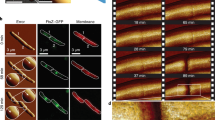Abstract
Escherichia coli is a rod-shaped bacterium that divides at its midplane, partitioning its cellular material into two roughly equal parts. At the appropriate time, a septum forms, creating the two daughter cells. Septum formation starts with the appearance of a ring of FtsZ proteins on the cell membrane at midplane. This Z-ring causes an invagination in the membrane, which is followed by growth of two new endcaps for the daughter cells. Invagination occurs against a cell overpressure of several atmospheres. A model is presented for the shape of the cell as determined by the tension in the Z-ring. This model allows the calculation of the force required for invagination. Then three possible models to generate the force necessary to achieve invagination are presented and analyzed. These models are based on converting GTP-bound FtsZ polymeric structures to GDP-bound FtsZ structures, which then leave the polymer. Each model is able to generate the force by relating the hydrolyzation to an irreversible molecular binding event, resulting in a net motion of putative anchors for the structures. All three models show that cross-linking the FtsZ protofilaments into a polymer structure allows the removal of GDP-FtsZ without interrupting the structure during force generation, as would happen for a simple polymeric chain.
Similar content being viewed by others
References
Anderson, D.E., Gueiros-Filho, F.J., Erickson, H.P., 2004. Assembly dynamics of FtsZ rings in Bacillus subtilis and Escherichia coli and effects of FtsZ-regulating proteins. J. Bacteriol. 186, 5775–781.
Beer, F.P., Johnston, E.R. Jr., 1992. Mechanics of Materials, 2nd edn. McGraw-Hill, Inc., New York.
Berman, H.M., , 2000. The protein data bank. Nucleic Acids Res. 28, 235–42.
Bramhill, D., 1997. Bacterial cell division. Ann. Rev. Cell Dev. Biol. 13, 395–24.
Cooke, R., 1986. The mechanism of muscle contraction. CRC Crit. Rev. Biochem. 21, 53–18.
DeBoer, P., Crossley, R., Rothfield, L.I., 1992. The essential bacterial cell-division protein FtsZ is a GTPase. Nature 359(6392), 254–55.
Drew, D.A., Osborn, M.J., Rothfield, L.I., 2005. A polymerization-depolymerization model that accurately generates the self-sustained oscillatory system involved in bacterial division site placement. Proc. Natl. Acad. Sci. 102, 6114–118.
Efremov, A., Grishchuk, E.L., McIntosh, J.R., Ataullakhanov, F.I., 2007. In search of an optimal ring to couple microtubule depolymerization to processive chromosome motions. Proc. Natl. Acad. Sci. 104(48), 19017–9022.
Elowitz, M.B., , 1999. Protein mobility in the cytoplasm of Escherichia coli. J. Bacteriol. 181, 197–03.
Erickson, H.P., Taylor, D.W., Taylor, K.A., Bramhill, D., 1996. Bacterial cell division protein FtsZ assembles into protofilament sheets and minirings, structural homologs of tubulin polymers. Proc. Natl. Acad. Sci. 93, 519–3.
Gonzalez, J.M., , 2003. Essential cell division protein FtsZ assembles into one monomer-thick ribbons under conditions resembling the crowded intracellular environment. J. Biol. Chem. 278, 37664–7671.
Goriely, A., Tabor, M., 2003. Biomechanical models of hyphal growth in actinomycetes. J. Theor. Biol. 222, 211–18.
Grishchuk, E.L., , 2008. Different assemblies of the DAM1 complex follow shortening microtubules by distinct mechanisms. Proc. Natl. Acad. Sci. 105, 6918–923.
Hale, C., Rhee, A., de Boer, P., 2000. ZipA-Induced Bundling of FtsZ Polymers. J. Bacteriol. 182, 5153–166.
Inoue, S., Salmon, E.D., 1995. Force generation by microtubule assembly/disassembly in mitosis and related movements. Mol. Biol. Cell 6, 1619–640.
Lan, G., Wolgemuth, C.W., Sun, S.X., 2007. Z-Ring force and cell shape during division in rod-like bacteria. Proc. Natl. Acad. Sci. 104, 16110–6115.
Lu, C., Erickson, H.P., 1999. The straight and curved conformation of FtsZ protofilaments-evidence for rapid exchange of GTP into the curved protofilament. Cell. Struct. Funct. 24, 285–90.
Lutkenhaus, J., Addinall, S.G., 1997. Bacterial Cell division and the Z-ring. Ann. Rev. Biochem. 66, 93–16.
Marrington, R., , 2004. FtsZ fibre bundling is triggered by a conformational change in bound GTP. J. Biol. Chem. 279, 48821–8829.
Mingorance, J., , 2001. Escherichia coli FtsZ polymers contain mostly GTP and have a high nucleotide turnover. Mol. Microbiol. 41, 83–1.
Mogilner, A., Elston, T., Wang, H.Y., Oster, G., 2002. In: Fall, C.P., Marland, E., Tyson, J., Wagner, J. (Eds.), Molecular Motors: Theory and Examples, pp. 321–80. Springer, New York.
Molodtsov, M.I., , 2005. Force production by depolymerizing microtubules: a theoretical study. Proc. Natl. Acad. Sci. 102, 4353–358.
Mukherjee, A., Lutkenhaus, J., 1998. Dynamic assembly of FtsZ regulated by GTP hydrolysis. EMBO J. 17, 462–69.
Peskin, C.S., Odell, G.M., Oster, G.F., 1993. Cellular motions and thermal fluctuations: the Brownian ratchet. Biophys. J. 65, 316–24.
Romberg, L., Levin, P.A., 2003. Assembly dynamics of the bacterial cell division protein FtsZ: poised at the edge of stability. Ann. Rev. Microbiol. 57, 125–54.
Small, E., Addinall, S.G., 2003. Dynamic FtsZ polymerization is sensitive to the GTP to GDP ratio and can be maintained at steady state using a GTP-regeneration system. Microbiol. 149, 2235–242.
Stoker, J.J., 1968. Nonlinear Elasticity. Gordon and Breach, New York.
Stricker, J., Maddox, P., Salmon, E.D., Erickson, H.P., 2002. Rapid assembly dynamics of the Escherechia coli FtsZ-ring demonstrated by fluorescence recovery after photobleaching. Proc. Natl. Acad. Sci. 99, 3171–175.
Timoshenko, S., 1940. Theory of Plates and Shells. McGraw-Hill, Inc., New York.
Westermann, S., , 2007. The Dam1 kinetochore ring complex moves processively on depolymerizing microtubule ends. Nature 440, 565–69.
Wood, J.M., 1999. Osmosensing by bacteria: signals and membrane-based sensors. Microbiol. Mol. Biol. Rev. 63(1), 230–62.
Yu, X.-C., Margolin, W., 1999. FtsZ ring clusters in min and partition mutants: role of both the Min system and the nucleoid in regulating FtsZ ring location. Mol. Microbiol. 32, 315–26.
Author information
Authors and Affiliations
Corresponding author
Additional information
This work is a partially the result of an Undergraduate Research Project (OS and RT). The support of the National Science Foundation Division of Mathematical Sciences and Division of Biological Sciences through Grant DMS 0214585 and a Supplement to support Undergraduate Research in Biology and Mathematics is appreciated.
Rights and permissions
About this article
Cite this article
Drew, D.A., Koch, G.A., Vellante, H. et al. Analyses of Mechanisms for Force Generation During Cell Septation in Escherichia coli . Bull. Math. Biol. 71, 980–1005 (2009). https://doi.org/10.1007/s11538-008-9390-6
Received:
Accepted:
Published:
Issue Date:
DOI: https://doi.org/10.1007/s11538-008-9390-6




